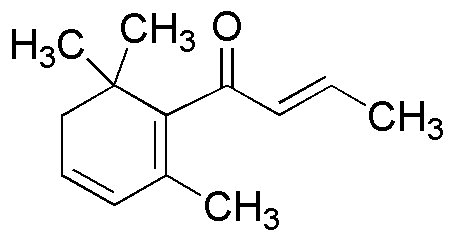Damascenone is widely utilized in research focused on
- Fragrance Industry: This compound is a key ingredient in perfumes and scented products, providing a floral and fruity aroma that enhances the overall scent profile.
- Flavoring Agents: Used in the food and beverage industry, it contributes to flavor formulations, particularly in fruit-flavored products, offering a natural and appealing taste.
- Cosmetics: Incorporated into skincare and cosmetic products, it serves as a fragrance component, improving the sensory experience of lotions, creams, and other beauty items.
- Aromatherapy: Employed in essential oils and diffusers, it is valued for its calming and uplifting properties, promoting relaxation and well-being.
- Research Applications: In scientific studies, it is used as a model compound for investigating scent perception and the chemistry of aroma compounds, aiding in the development of new fragrance technologies.
General Information
Properties
Safety and Regulations
Applications
Damascenone is widely utilized in research focused on
- Fragrance Industry: This compound is a key ingredient in perfumes and scented products, providing a floral and fruity aroma that enhances the overall scent profile.
- Flavoring Agents: Used in the food and beverage industry, it contributes to flavor formulations, particularly in fruit-flavored products, offering a natural and appealing taste.
- Cosmetics: Incorporated into skincare and cosmetic products, it serves as a fragrance component, improving the sensory experience of lotions, creams, and other beauty items.
- Aromatherapy: Employed in essential oils and diffusers, it is valued for its calming and uplifting properties, promoting relaxation and well-being.
- Research Applications: In scientific studies, it is used as a model compound for investigating scent perception and the chemistry of aroma compounds, aiding in the development of new fragrance technologies.
Documents
Safety Data Sheets (SDS)
The SDS provides comprehensive safety information on handling, storage, and disposal of the product.
Product Specification (PS)
The PS provides a comprehensive breakdown of the product’s properties, including chemical composition, physical state, purity, and storage requirements. It also details acceptable quality ranges and the product's intended applications.
Certificates of Analysis (COA)
Search for Certificates of Analysis (COA) by entering the products Lot Number. Lot and Batch Numbers can be found on a product’s label following the words ‘Lot’ or ‘Batch’.
*Catalog Number
*Lot Number
Certificates Of Origin (COO)
This COO confirms the country where the product was manufactured, and also details the materials and components used in it and whether it is derived from natural, synthetic, or other specific sources. This certificate may be required for customs, trade, and regulatory compliance.
*Catalog Number
*Lot Number
Safety Data Sheets (SDS)
The SDS provides comprehensive safety information on handling, storage, and disposal of the product.
DownloadProduct Specification (PS)
The PS provides a comprehensive breakdown of the product’s properties, including chemical composition, physical state, purity, and storage requirements. It also details acceptable quality ranges and the product's intended applications.
DownloadCertificates of Analysis (COA)
Search for Certificates of Analysis (COA) by entering the products Lot Number. Lot and Batch Numbers can be found on a product’s label following the words ‘Lot’ or ‘Batch’.
*Catalog Number
*Lot Number
Certificates Of Origin (COO)
This COO confirms the country where the product was manufactured, and also details the materials and components used in it and whether it is derived from natural, synthetic, or other specific sources. This certificate may be required for customs, trade, and regulatory compliance.


